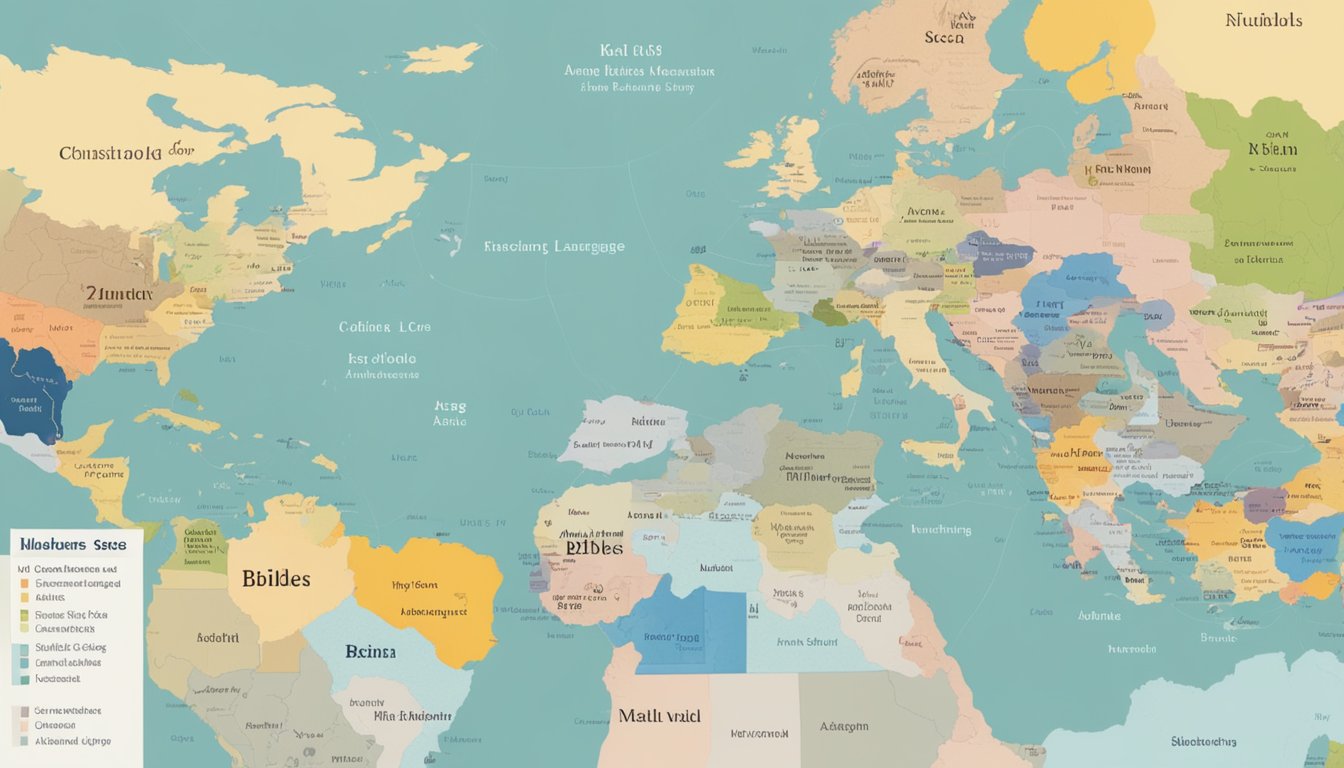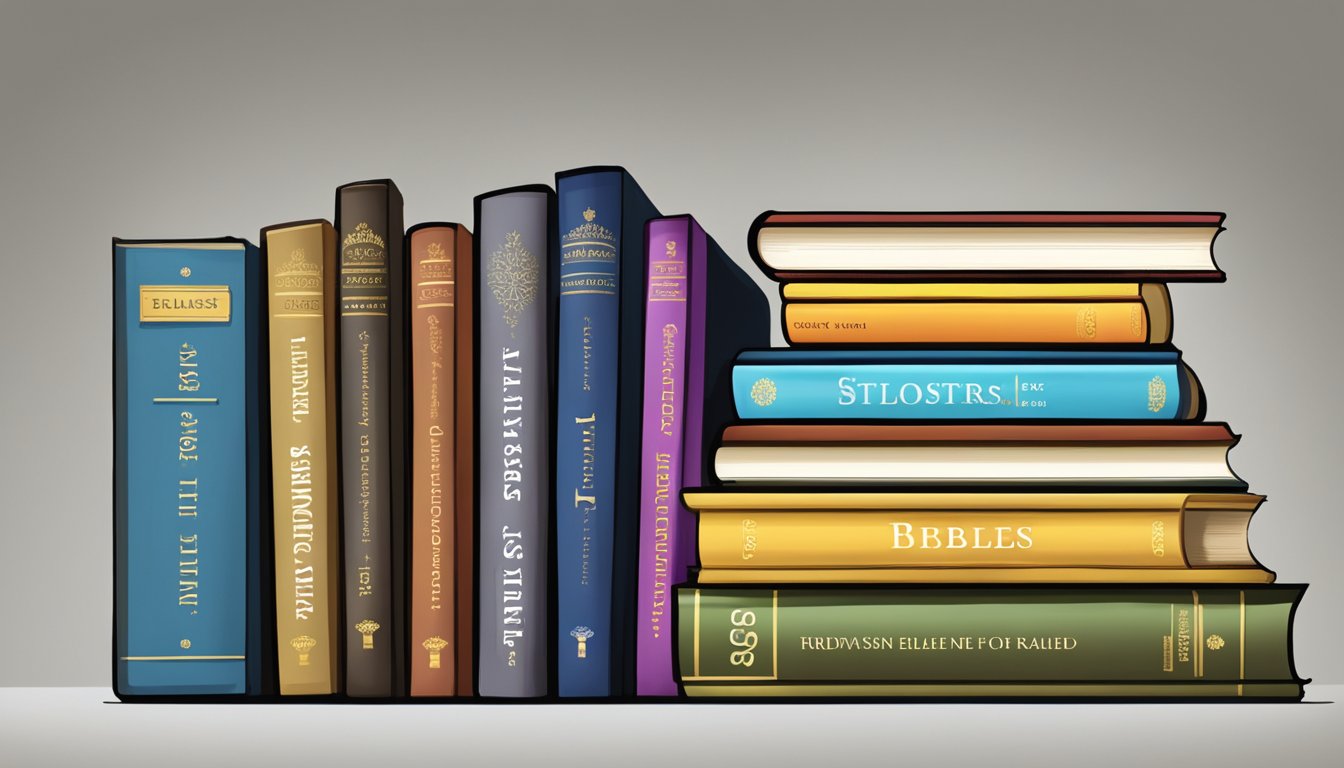The Bible, often considered the foundational text of Western civilization, continues to be a ubiquitous presence in society, influencing the lives of millions around the globe. As one of the most recognized and widely distributed books in history, its sales figures are a testament to its enduring relevance and impact. Each year, the Bible achieves remarkable sales, outpacing many contemporary bestsellers, and maintaining its significance across diverse cultures and communities.

How Many Bibles are Sold Each Year?

The production and dissemination of the Bible have evolved substantially since the inception of the printing press, adapting to changes in technology, language, and societal norms. The digital age has further revolutionized its availability, with numerous versions and translations now accessible to a global audience at the click of a button. Despite these advances, the printed Bible remains in high demand, frequented by individuals for personal study, gifted by organizations for educational purposes, and sought by collectors for its literary significance.
Key Takeaways
- The Bible is one of the most frequently sold books, demonstrating its persistent impact.
- Bible acquisition adapts to cultural and technological shifts, reflecting modern availability.
- Print and digital editions of the Bible continue to be highly sought after worldwide.
Historical Context of Bible Publishing
The journey of Bible publishing is a remarkable narrative that begins with the Gutenberg Bible, first printed in the 15th century. This monumental event introduced the era of mass-produced books and made literature, including the Bible, more accessible to a broader audience.

With innovation in print technology, more people could own a copy of the Bible, leading to an increase in its translations. A noteworthy translation came in 1611 with the creation of the King James Version (KJV), a cornerstone in English literary works and religious studies. The production and dissemination of the KJV set a high bar for English translations of biblical texts.
Over the centuries, numerous translations have emerged, addressing various linguistic preferences and reading levels. The New International Version (NIV), first published in the 1970s, has been widely embraced for its clarity and ease of understanding.
For those seeking a more literal translation, the English Standard Version (ESV) offers an alternative that stays close to the original Hebrew, Aramaic, and Greek texts. On the other hand, the New Living Translation (NLT) presents the scriptures in modern, conversational English, aiming to make the text as comprehensible as possible.
The range of translations means that, today, readers can select a version aligned with their personal study needs or devotional preferences. The continual evolution of Bible publishing reflects the enduring demand and the book’s significant place in literary and cultural history.
Global Bible Sales Overview
The landscape of Bible distribution paints a picture of enduring demand across the globe. Annually, 100 million bibles are printed and disseminated to cater to the spiritual and literary appetite of believers and readers alike. Recently, data has highlighted some fluctuations in these numbers, influenced by global events such as the pandemic.
In 2021, after experiencing a sharp decline at the onset of the coronavirus pandemic, Bible sales saw an encouraging resurgence. This recovery continued into 2022, witnessing a distribution of approximately 35.5 million Bibles by Bible societies around the world. This represented an increase of around three million copies in comparison to the previous year, showcasing the Bible’s steady presence in international book markets.
Specifically, the United States remains one of the largest markets for Bible sales, with over one billion dollars in sales reported annually. Aside from being a cherished possession for many, Bibles are frequently given as gifts for occasions like graduations, weddings, and birthdays.
| Year | Bibles Distributed Worldwide |
|---|---|
| 2021 | Approx. 32.5 million copies |
| 2022 | Approx. 35.5 million copies |
Such statistics correspond to both full Bibles and Scripture portions combined. The trajectory of Bible sales indicates not just a cultural and religious interest but also signifies the role of printed scripture in contemporary society, even with the increasing availability of digital formats.
Bible Distribution and Availability
The global spread of the Bible relies on diverse methods to reach different audiences, with the efforts of Bible societies playing a significant role. Bibles are shared both through physical print and digital formats, ensuring accessibility across various platforms.
Distribution Methods
Bible distribution occurs through a multitude of channels to maximize reach. Physical copies are often dispersed through churches, bookstores, and through direct sales. In addition to print, there is a growing emphasis on digital versions, which are distributed via downloads from various websites and applications.
Accessibility Online and Offline

The digital Bible has significantly increased the accessibility of scripture. Online platforms offer a variety of versions that can easily be downloaded to a personal device, while offline efforts include the distribution of CD-ROMs and USB drives containing Bible texts. This ensures that individuals have access to the Bible regardless of their internet connectivity.
Role of Bible Societies
Bible Societies, such as the United Bible Societies, are central to the mission of making the Bible available to every person. They work collaboratively across nations to translate, produce, and provide Bibles worldwide. Their distribution reports reveal substantial numbers, such as 35.5 million Bibles distributed around the world in 2022, highlighting the ongoing effort to disseminate this literature globally.
Bible Sales by Region and Language

Bible sales vary significantly across different regions, with language playing a pivotal role in dissemination. These sales trends highlight the cultural and linguistic diversity that shapes the global religious landscape.
United States Market
In the United States, it is estimated that 20 million Bibles are sold each year—an impressive figure reflecting the country’s considerable Christian population. These sales account for a diverse range of English-language publications, with special editions such as study Bibles catering to a variety of American denominational preferences.
European Influence
While Europe has seen a decline in Bible sales in some countries, the region still has a significant impact on the spread of the Bible, particularly in Spanish, among other European languages. Certain European countries demonstrate slower rates of decline, indicating variances in religious engagement and cultural interest in scripture across the continent.
Expansion in India and China
In India and China, the growth of Bible sales is substantial, with sales in China reaching over 15 million copies. This surge is indicative of the burgeoning Christian communities and the increasing availability of Bibles in various native languages, including Mandarin and regional Indian languages. The rise in Bible sales in these populous countries is a testament to the spread of Christianity in diverse linguistic contexts.
Impact of Digital Formats on Bible Availability
« Exploring the List of Christian Countries in the World: Understanding Christianity’s Global Presence and Impact
St. Anthony Prayer for Lost Items: A Guide to Finding What You’ve Misplaced »
The availability of the Bible has been significantly enhanced by digital formats, allowing it to be accessed across various devices and platforms. This has reshaped how people engage with this sacred text.
E-books and Digital Downloads
Digital Bibles, often found in e-book formats, are increasingly embraced. The ease with which these can be downloaded directly to an e-reader, computer, or tablet has contributed to this rise. Unlike traditional print copies, these digital versions are often more affordable or even free, which broadens their accessibility. Websites offer an array of translations and versions, catering to a diverse audience seeking different interpretations of the Bible.
The Rise of Bible Apps
Bible apps have particularly thrived in the digital era. Many people use their smartphones to interact with the Bible, and these apps offer features beyond just the text. Users can set reading plans, receive daily verses, participate in study groups, and much more. The impact is noticeable, with Bible Society reporting a considerable distribution of Bibles via these digital channels. As the Bible moves into the realm of these applications, it becomes intertwined with daily digital habits, making the scripture just a tap away.
The transition towards digital platforms has been fueled by the widespread availability of the internet, which has played a pivotal role. It’s not only improved distribution but also fostered a new way of experiencing the Bible, making digital Bibles easily accessible for a new generation of tech-savvy readers.
Popular Bible Versions and Translations

The diversity of Bible translations reflects their use in worship, study, and personal reading. They range from traditional texts preserved over centuries to modern translations that seek to make the scriptures accessible to a contemporary audience.
Traditional and Modern Translations
Traditional Translations:
- King James Version (KJV): Known for its majestic language, the KJV has been a staple in Christian communities since 1611. Despite newer translations, it remains a beloved choice and, as of June 2021, was the fourth best-selling translation.
- New King James Version (NKJV): The NKJV updates the language of the KJV to reflect more modern English while maintaining the original style and beauty.
Modern Translations:
- New International Version (NIV): The NIV is praised for its balance between readability and faithfulness to the original texts. It has consistently been a top seller and was the leading translation at the end of 2022.
- English Standard Version (ESV): The ESV is a relatively newer translation that aims for literary excellence and a clear, direct style in modern English. It ranked second in best-selling translations at the end of 2022.
Bible as Literature and Cultural Influence
The Bible is not just a religious text but also a significant work of literature that has profoundly influenced global culture and education.
Bible in Educational and Cultural Contexts
In educational settings, the Bible is frequently studied for its rich tapestry of narratives that offer insights into ancient history and ethics. Literature courses often include the Bible for analysis, appreciating its complex characters and influential narratives that have shaped societal norms and morals. It provides foundational knowledge that intersects with various disciplines, including history, philosophy, and the arts.

In cultural contexts, biblical themes and figures, particularly Jesus and his teachings, are interwoven into the fabric of societal values and artistic expressions. References and allusions to the Bible can be observed in innumerable works of music, film, and literature. For instance, the use of parables—succinct stories delivering wisdom—can be traced to Jesus’s teaching methods and is a common literary device.
Literary Significance
The Bible’s literary significance lies in its diverse genres and stylistic elements. It encompasses poetry, narrative, and prose, often employing symbolic language and allegories to impart its teachings and wisdom. Its varied literary forms have become canonical examples of ancient writing that continue to inform modern literature.
As an anthology of texts, the Bible offers a panoply of stories with complex character development and moral quandaries, which foster critical thinking and influence contemporary storytelling. Its relevance persists in modern discourse, as readers across generations and cultures find personal and societal significance in its passages.
Economic Aspects of Bible Sales

Bible sales contribute significantly to the publishing industry, with revenues from these sales forming a considerable part of the market. As the most widely distributed book, the demand for Bibles ensures a steady stream of income for publishers.
The impact of Bible sales on the economy can be measured in the following areas:
- Sales Volume: Approximately 20 million Bibles are sold each year in the United States alone, evidencing a consistent consumer demand.
- Revenue: This volume translates to substantial sales revenue for publishers. The price per Bible can vary, affecting total revenue.
- Production and Distribution: The number of Bibles printed and sold worldwide necessitates a significant operation in terms of production and logistics, which in turn fuels jobs within these sectors.

The following is a snapshot of Bible sales data:
| United States Sales | Global Impact |
|---|---|
| 20 million Bibles per year | Over 5 billion copies sold historically |
| 1.66 million Bibles per month | Best-selling book in China with over 10 million Bibles sold annually |
| 54,945 Bibles sold every day | Sales tripling in India since 2000 |
The sale of Bibles doesn’t operate in isolation. They are intricately linked with technological advances, such as e-books and mobile apps, which also influence revenue and market trends within the broader publishing industry. Publishers adapt to changes, ensuring that printed materials, digital versions, and various translations continue to reach different demographic groups. This adaptability helps maintain the Bible’s position as a key product in the religious book market segment, thereby sustaining its economic impact over time.
Bible Purchase Motivations and Trends
The purchase of Bibles is influenced by a variety of factors, ranging from seasonal gifting patterns to individuals seeking personal growth and inspiration. Understanding these motivations provides insight into the ongoing relevance and impact of this religious text.

Seasonal and Gift Purchases
During specific times of the year, Bible sales often see a notable increase. They are commonly bought as gifts for occasions such as Christmas, Easter, and significant life events like weddings and graduations. In the United States, Bibles have become a popular gift item, akin to the way some fantasy series, like Harry Potter, might be gifted to fiction enthusiasts. This trend reflects Bibles’ dual role as both sacred texts and traditional presents.
Inspirational and Personal Growth
For many, Bibles serve as a source of inspiration, guidance, and comfort. People purchase Bibles for personal use to explore their faith, reflect on spiritual teachings, or seek solace during challenging times. According to a survey by the American Bible Society, individuals often turn to the Bible to enhance their understanding of religious beliefs, which, in turn, can have a significant impact on their personal and spiritual lives. This search for inspiration and guidance drives a continual demand for the Bible year-round, beyond the seasonal spikes associated with gift-giving.
Role of Churches and Religious Organizations


Churches and religious organizations play a pivotal role in the distribution and sales of Bibles. They incorporate Bible dissemination into their core missions, profoundly impacting annual sales figures. Many Christian bookstores are directly affiliated with or influenced by churches, extending the reach of Bible sales.
- Churches: Often provide Bibles free to their members and sometimes to visitors, seeing the distribution of the holy text as part of their spiritual mandate. They may also encourage members to gift Bibles, driving sales.
- Christianity: As the religion based on the teachings of the Bible, Christianity naturally promotes the purchase and study of the Bible both within and beyond the church setting.
Religious organizations, including evangelical churches, often engage in extensive missionary work and community outreach programs, distributing Bibles as part of their evangelistic efforts. This contributes to an increase in Bible sales and distribution around the world.
Christian Bookstores: These specialty stores, often supported by or in partnership with local churches, sell Bibles and other religious books, providing a variety of versions and translations that appeal to diverse audiences.
Religious Organizations:
- Offer Bibles at conferences, retreats, and other events.
- May fundraise to distribute Bibles nationally and internationally.
In summary, religious groups not only contribute directly to Bible sales through purchases but also foster a culture that values owning and reading the Bible, thereby sustaining demand.
Bible in the Digital Age and Future Outlook


The shift towards digital media has seen the Bible becoming increasingly available in electronic formats. This transition is shaping how people access and engage with the Scriptures.
Digital Trends and Future Projections
The sales of print Bibles are maintaining their significant numbers with millions still sold annually. However, there’s a growing trend where people are turning to digital Bibles, including e-books and audiobooks, for convenience and accessibility. The current figures suggest that alongside the physical copies, there’s a considerable consumption of Scripture in digital formats.
The trend of digital consumption includes downloads of Bible applications on smartphones and tablets, which facilitate reading on-the-go. The younger generation, in particular, seems to prefer having the Bible available at their fingertips in various digital versions. These versions often come with added features such as search functions, annotations, and reading plans, enhancing the user experience.
As technology advances, future projections indicate a continued rise in the popularity of digital Scriptures. The Bible is likely to see adaptations with interactive content and potentially virtual reality experiences, as the appetite for e-books and audiobooks endures and evolves. This could further solidify the presence of the Bible in the digital space, maintaining its relevance in an increasingly technology-driven world.
Frequently Asked Questions

This section addresses some of the most common inquiries about the Bible’s sales, translations, and pricing.
What are the annual sales figures for the Bible in the United States?

In the United States, roughly 20 million Bibles are sold each year, reflecting its continued popularity and significance amongst readers.
Can we rank the Bible as the top-selling book annually?
Yes, the Bible is often considered the top-selling book annually, with millions of copies being distributed around the globe every year.
What are the most popular Bible translations based on sales in 2023?
While specific sales data for 2023 is not stated, historically popular translations include the NIV (New International Version), KJV (King James Version), and the ESV (English Standard Version).
How does the pricing of various Bibles differ?
The pricing of Bibles can vary greatly based on factors such as the type of cover, print quality, translation, and additional features like commentary or study aids.
In how many different languages has the Bible been translated to date?
As of now, the Bible has been translated into over 3,000 languages, which helps to extend its reach to diverse populations worldwide.
What is the total number of Bibles sold globally?

Globally, it is estimated that over 5 billion copies of the Bible have been sold, making it one of the best-selling books in history.










